On the Road is a weekday feature spotlighting reader photo submissions.
From the exotic to the familiar, whether you’re traveling or in your own backyard, we would love to see the world through your eyes.
Sometimes I am totally surprised to see what a new country looks like, but in this case India looks just like I guessed it might. So interesting! Let’s give a warm welcome to our new commenter! ~WaterGirl
Warren Senders
Howdy, Jackals.
Long-time lurker, not much of a commenter. Perhaps that will change with this post.
I lived in India in the 1980s and 1990s, studying music in the city of Pune. I thought I’d share a few images from my life there, and if you like ’em, I’ll share more, both from my daily life and from my travels elsewhere in India (Kashmir, Rajasthan, Delhi, Chennai, Varanasi, etc.).
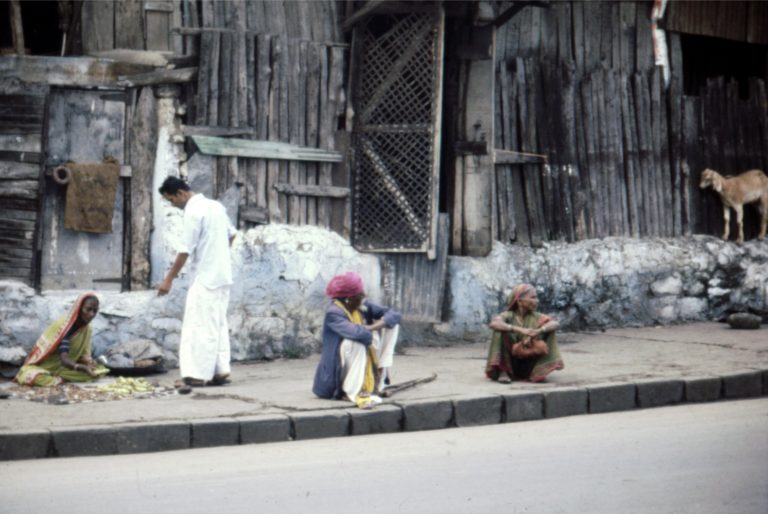
As a resident of the city, I was less focused on photographing the Big Important Places And Things. What moved me were the little glimpses of ordinary life. People everywhere, waiting for something or other, squatting on their haunches in a naturally-relaxed way that I could never manage comfortably. Goats, equally everywhere. The near-ubiquitous pale-blue whitewash on walls and foundations. The street vendors selling whatever the heck it was they were selling.
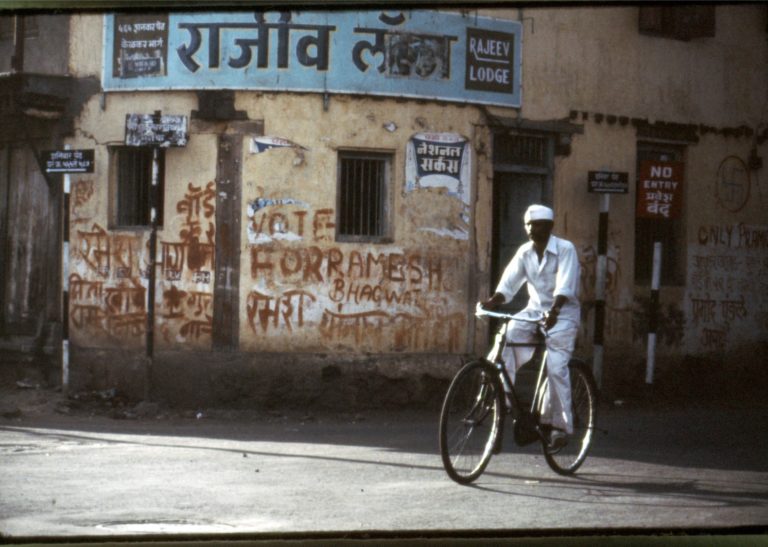
The “City” section of Pune was a maze of narrow streets, usually clogged with traffic that included everything from trucks and buses to water buffalo on their way to or from a refreshing wallow. And everywhere, bicycles. Normally the congestion was intense; accidents were very common, and cycling from my apartment to points in the city (no helmets!) was a fraught endeavor. This brave soul all alone in the middle of an intersection is an anomaly.

The street vendors offered all sorts of delicious things. Watermelon on a hot day was incredibly refreshing; you try not to think about what might have landed on those surfaces and just taste the sweetness.
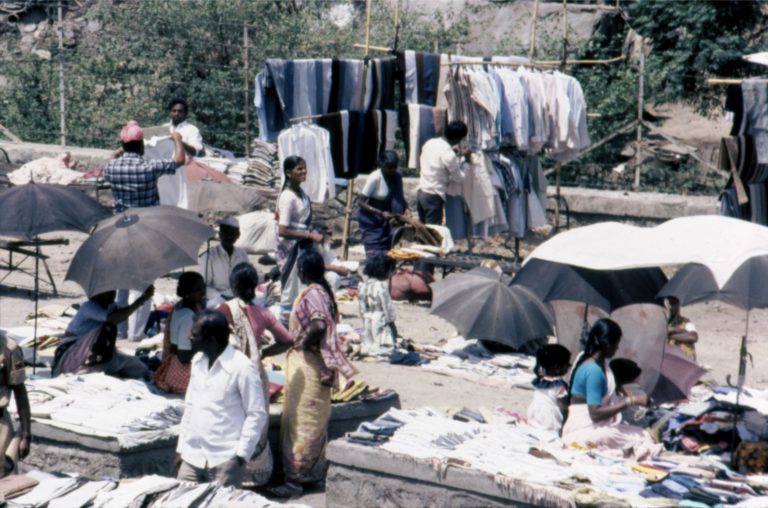
My moves through the city took me past some fascinating places. A lifelong devotee of flea markets, I was naturally drawn to the Jhula Bazaar, a continuous junk sale that unfolded along one of the main roads for about a kilometer. I once bought a suitcase there for an emergency travel requirement; the zipper burst en route to the airport, and I wound up having to sew it shut with a big leather needle and stout twine (both of which I’d presciently purchased at the time).
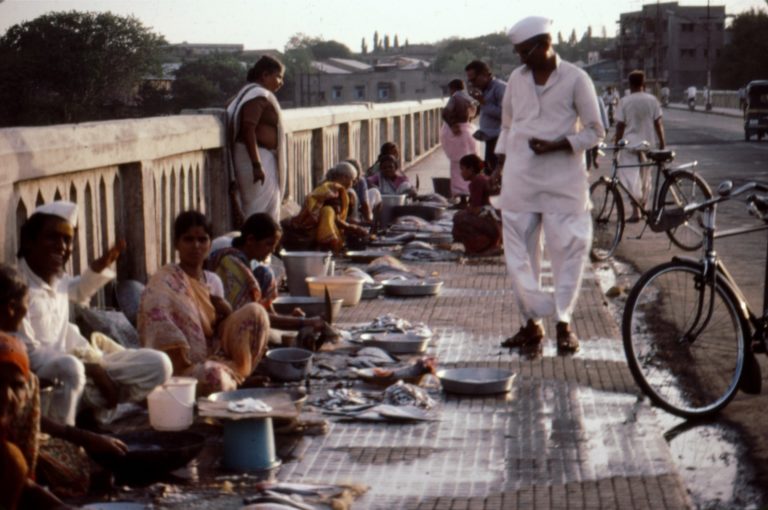
Pune rests at the intersection of the Mula and Mutha rivers (which join to become the Mula-Mutha). I’m not a fish-eater, but if you’re not too picky about what the catch of the day ate yesterday, there were always fishmongers monging fish.
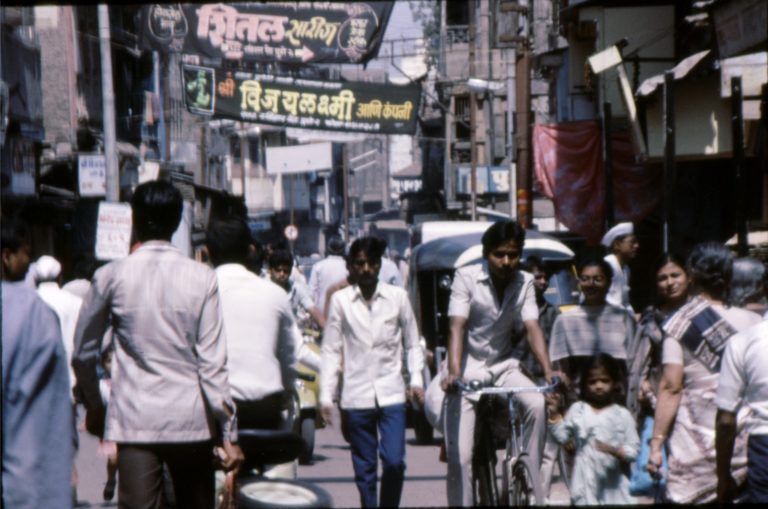
I lived in a residential area, in a comfortable apartment. But I went into the city center several times a week to purchase necessities. While exhausting — the combination of extreme pollution, extreme heat, extreme noise, and extreme Event Density will do that to ya — it was also stimulating. My love for cities has never been so fulfilled.
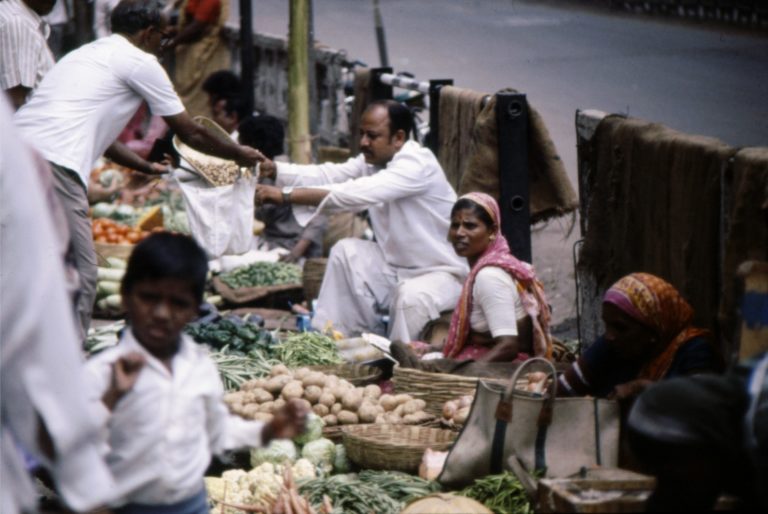
Vegetables. Always vegetables. Things have changed a bit since then, and while there are still some some streetside sellers, more and more people get their veggies in stores. I was a terrible bargainer, but someone with real chops in this kind of give-and-take could do remarkably well.
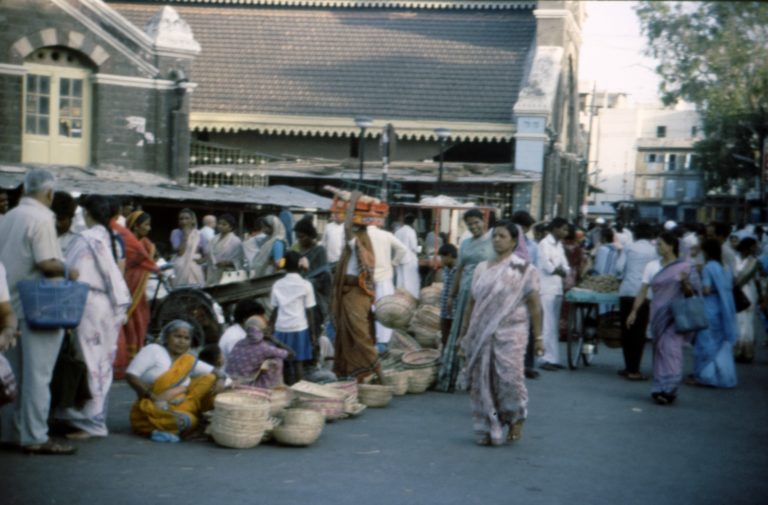
For the best deals on vegetables you had to go to the very center of the city, to the Phule Market. In the early morning hours there would be trucks unloading produce from farms outside the city, and by 10 AM the area would be clogged with purchasers stocking up for the week. In America a trip to the grocery store (at least before the Plague) is not a fraught & exhausting errand, in mid-80s Pune any venture out of the house required an equal time spent in recovery, either at home or in a coffee shop on the way. Caffeine & sugar, relative darkness, relative quiet.

Benno
Great pics, Warren, but you show us India in the 80s/90s and not one of the Ambassador to be seen? Loved the memories. I lived in Chennai in the mid 90s, did graduate research near Puducherry a decade latter. I live in Karachi now (studying music!), and it almost looks the same. But no Ambassadors anymore.
gene108
@Benno:
Also, no auto rickshaws ? in the photos.
Wanderer
The photos are very interesting. I was almost able to feel the press of the crowds. Thanks for posting and welcome.
JPL
Oh the places this blog goes. Like Water Girl stated, it does look like I imagined. I’m not sure I could adjust to living in such a populated area.
satby
I love India too, though I’ve spent most of my time in Delhi when I was there. Your description of Pune in the 80s sounds like old Delhi today. Welcome Warren Sanders!
J R in WV
Fabulous photo set, thanks for sharing!
Always want to welcome a new Jackal!
Just an observer
@gene108: Hey, you need to see Pic #3 again!
Jerry
I listened to some of your music so I had to look at your photos again with the Barmer Boys playing on Youtube in another tab. Great photos, but my reflex right now, unfortunately, is that I feel a bit of a shock seeing all those folks together and no one wearing a mask. Then I remembered that this was pre-Covid.
KSinMA
Fascinating photos and commentary. Thanks!
jalcirrus
From another long time lurker – Great photos Warren! I’ve been to India twice – after college in the 90s I traveled across the North for six weeks and then later across the southern part of the country. India was incredible! Like you, I have photos of the “Big Important Places,” but the majority of my photos are of street scenes of everyday life. Thanks for the memories!
cain
Huh.. wow the streets are unusually clean. My memories of India in the 80s (I used to go every summer for 3 months) – was just how badly sanitation was in Bombay. Maybe Pune was just so much better in regards to that. I didn’t visit Pune very much in the 80s.
Now of course we got a proper sanitation department and regular trash picks ups.. in the 80s, we just threw that stuff in a 4×4 cement container open air, and ugh.
JanieM
@Jerry:
I do this all the time! Just a little whiff of a thought that goes through my mind: “they’re not masked.” Then I remember.
But — I’ve done this for years in relation to cell phones. I’ll be reading a novel, and someone gets stuck in a situation where things would be less difficult if only they could call someone, and some little corner of my imagination thinks, “Well why don’t you call!” Then I remember: no cell phones.
It’s weird. I never did this with, let’s say, the automobile, or landline phones. Maybe it’s because the automobile and the landline have been facts of life for my entire life, whereas cell phones are new, and masks are new (and I hope temporary….)
Great pics — sorry for the sidetrack. I spent a month in China when my son was teaching there and the bargaining thing was a challenge. We are too literal-minded (he and I, I mean, not necessarily Americans in general). The food in open markets is also an echo of China for me. Pigs’ heads, anyone?
Warren Senders
@Benno: You’re studying music in Karachi? Tell me more! What styles? I am a khyaliya of mixed Gwalior/Jaipur/Agra styles, if that means anything to you.
I was supposed to do a concert tour of Pakistan in the fall of 2001, including an appearance at the All-Pakistan Music Conference, but 9/11.
There are plenty of Ambassadors in other photos…so perhaps you’ll see them in subsequent posts, which might include Delhi, Varanasi, Jaipur, Kashmir…
Warren Senders
@cain: Plenty of mess to be found in Pune, then and now. But I didn’t really feel like photographing it!
Warren Senders
@gene108:
Pune is very close to the Tata manufacturing site, so Pune rickshaws are generally a couple of years ahead of the rest of India. Next set of photos I promise to include one or two!
Warren Senders
@Jerry:
I get that constantly with movies now.
Mai Naem mobile
We went to India when the Clintons were there. I think we were a couple of days behind them and following almost the same route(Delhi,Agra,Rajasthan.) Our drivers would joke about how the Clintons should visit every year because the government had made an extra effort to clean up. Anyhow we landed late in Delhi and had issues getting out of the airport because security was tight because of the Clinton visit. It was around midnight and our driver takes us to the car in the parking lot and there’s a cow sitting next to the vehicle. Welcome to India! Lol
Warren Senders
@JanieM:
Very few land lines either! At the time, there was a whole occupation: musicians’ messenger. Usually a teenaged boy charged with carrying slips of paper back and forth between musicians in order to arrange rehearsals and gigs.
cain
It was refreshing not to see it! The interesting bit about us as a people is that – we hold cleanliness to be an important thing. But we’re also selfish. When I used to walk by shanty towns – 2 or 3 ft from the entrance everything is tidy and clean beyond that it’s dirt hills filled with feces.
It’s always been a feeling of frustration that shanty town dwellers lack the communal feeling of keeping their neighborhood clean. Then again, they are pretty much squatting on that land – no taxes being paid so no govt services either. We chat a lot about it when I’m there.
cain
haha, yeah, our house had a phone and every once in awhile people would come over to use it. But most homes did not have a phone in the 80s. I believe it was a lot like Russia – kind of the same thing – a whole village will have one phone to share.
When I visited in 1982 – Indians finally got color TV! Huge crowds in front of stores. It was kind of neat.
Also, 80s India had a very weird communist feel. Then again, we schools would get the day off when a Russian dignitary showed up.
WaterGirl
@jalcirrus: Warm welcome to you, too!
cain
@Mai Naem mobile:
It’s too bad y’alls didn’t go South – there are some really nice sights to see – the culture and land is completely different than the north.
Benno
@Warren Senders: I actually came here in 2012 for other reasons, but a friend introduced me to the great grand nephew of the man who adapted the Japanese taisho-goto into the Balochi banjo. It’s mostly a folk instrument now, but my teacher’s grandfather (the inventor’s younger brother) was a classically trained sitarist who learned Gwalior style at the knee of Mian Mubarak Ali Khan. When he was introduced to the khan sahab in the early 30s, he told him sitar players were a dime a dozen (I’m paraphrasing) and he should take up his brother’s invention. Earlier recordings are hard to find, but I’ve managed to salvage a few from acetate tapes in the family’s possession.
Warren Senders
@Benno:
Wow! I love Baluchi music, and the Baluchi “banjo” (aka “bulbul tarang”) is a most remarkable instrument in the hands of a skilled player.